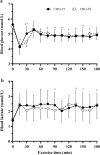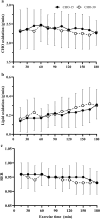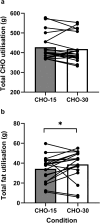Different Carbohydrate Ingestion Patterns Do Not Affect Physiological Responses, Whole-Body Substrate Oxidation or Gastrointestinal Comfort in Cycling
- PMID: 40489306
- PMCID: PMC12147858
- DOI: 10.1002/ejsc.12336
Different Carbohydrate Ingestion Patterns Do Not Affect Physiological Responses, Whole-Body Substrate Oxidation or Gastrointestinal Comfort in Cycling
Abstract
Fuelling during endurance exercise has evolved towards greater amounts of carbohydrates (CHO) ingested per hour, which can prove challenging for athletes. However, the effects of different CHO ingestion patterns during exercise have scarcely been investigated in cycling. 20 recreationally active males cycled for 180 min at lactate threshold on two occasions in a randomised counterbalanced order. Participants consumed 90 g/h of CHO, either as 22.5 g every 15 min or 45 g every 30 min (CHO-15 and CHO-30, respectively). Respiratory gases, blood glucose, lactate, heart rate, RPE and gastrointestinal symptoms were assessed every 15 min. Physiological responses showed no difference between conditions or significant interactions, except for blood glucose which saw a greater increase in CHO-15 during the first 30 min (interaction; p = 0.03). Whole body CHO and fat oxidation were not different between conditions (2.38 ± 0.37 and 2.33 ± 0.39 g/min, p = 0.25 and 0.19 ± 0.07 vs. 0.22 ± 0.08 g/min, p = 0.10 for CHO-15 and CHO-30, respectively). Subjective markers of gastrointestinal symptoms did not differ between conditions (p > 0.05) except for urge to defecate (p = 0.05); however, only 1 participant reported a score > 4 across any symptoms. Ingesting a larger CHO amount at less regular intervals during prolonged cycling had minimal impact on physiological responses to exercise, whole-body substrate oxidation and gut discomfort, allowing athletes to freely select their preferred strategy.
Keywords: endurance exercise; exercise metabolism; performance; sport nutrition.
© 2025 The Author(s). European Journal of Sport Science published by Wiley‐VCH GmbH on behalf of European College of Sport Science.
Conflict of interest statement
The authors declare no conflicts of interest.
Figures




Similar articles
-
Effect of Glycemic Index of a Pre-exercise Meal on Endurance Exercise Performance: A Systematic Review and Meta-analysis.Sports Med. 2017 Jun;47(6):1087-1101. doi: 10.1007/s40279-016-0632-8. Sports Med. 2017. PMID: 27677914
-
Could It Bee? Honey Ingestion Induces Comparable Metabolic Responses to Traditional Carbohydrate-Based Sports Nutrition Product During 3-Hr Steady-State Cycling and Subsequent Exercise Capacity Test.Int J Sport Nutr Exerc Metab. 2025 Jul 15:1-9. doi: 10.1123/ijsnem.2024-0244. Online ahead of print. Int J Sport Nutr Exerc Metab. 2025. PMID: 40675563
-
Carbohydrate supplementation maintains physical performance during short-term energy deficit despite reductions in exogenous glucose oxidation.Am J Physiol Endocrinol Metab. 2025 Feb 1;328(2):E242-E253. doi: 10.1152/ajpendo.00418.2024. Epub 2025 Jan 15. Am J Physiol Endocrinol Metab. 2025. PMID: 39814548 Clinical Trial.
-
Systemic pharmacological treatments for chronic plaque psoriasis: a network meta-analysis.Cochrane Database Syst Rev. 2021 Apr 19;4(4):CD011535. doi: 10.1002/14651858.CD011535.pub4. Cochrane Database Syst Rev. 2021. Update in: Cochrane Database Syst Rev. 2022 May 23;5:CD011535. doi: 10.1002/14651858.CD011535.pub5. PMID: 33871055 Free PMC article. Updated.
-
Feeding Tolerance to a Running Gut-Challenge Protocol: a Cross-Sectional Exploration.Int J Sports Med. 2025 Jun;46(7):510-524. doi: 10.1055/a-2541-2821. Epub 2025 Apr 27. Int J Sports Med. 2025. PMID: 40288407
References
-
- Cohen, J. 1988. Statistical Power Analysis for the Behavioral Sciences. 2nd ed. Routledge. 10.4324/9780203771587. - DOI
Publication types
MeSH terms
Substances
LinkOut - more resources
Full Text Sources
Medical

